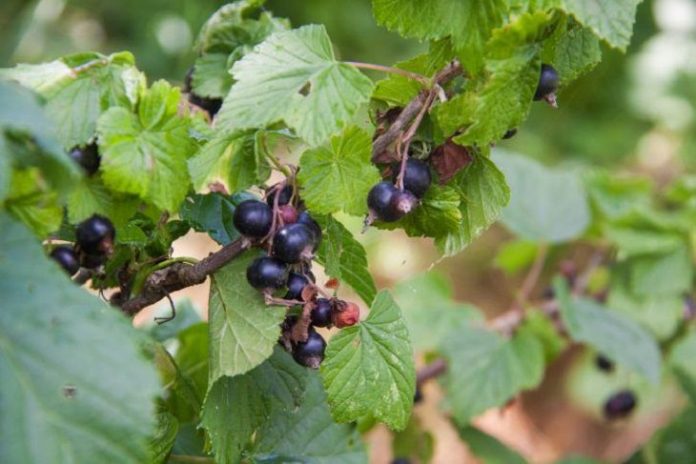Currant is a berry loved by many, which requires a special approach to choosing neighbors in the garden..
Proper placement of crops in the garden not only increases productivity, but also protects plants from pests and diseases..
What plants should absolutely not be planted next to currants?
Walnut
Walnuts produce a substance called juglone, which is toxic to many plants, including currants.
This substance inhibits the growth and development of shrubs, which can lead to its death.Therefore, currants should be planted at a distance of at least 10-15 meters from nut trees.
Raspberry
Despite the fact that raspberries and currants are berry crops, their proximity is undesirable.
These plants compete for nutrients and moisture in the soil, which negatively affects the yield of both crops.In addition, raspberries are prone to rapid growth, which can lead to choke of currants.
Gooseberry
Gooseberries and currants are susceptible to the same diseases, such as powdery mildew and anthracnose.
The close proximity of these bushes increases the risk of spreading infections and complicates the fight against them.It is recommended to plant these crops in different parts of the garden.
Cherries and sweet cherries
Stone fruit trees such as cherries and cherries are not the best neighbors for currants.
They can infect the bush with verticillium wilt, a dangerous fungal disease that causes branches to die and the plant to die.
Tomatoes and potatoes
Nightshade crops, which include tomatoes and potatoes, can be carriers of viral diseases that are dangerous for currants.
In addition, these plants attract pests that can spread to berry bushes.
The right companions
To create favorable conditions for currant growth, it is worth paying attention to companion plants that promote its development and protection from pests.
Legumes such as peas and beans enrich the soil with nitrogen, which has a beneficial effect on the growth of currants.
Garlic and onions repel pests with their strong smell, creating a natural protective barrier. Calendula and marigolds not only decorate the garden, but also repel nematodes that can damage the root system of currants.
Correct placement
When planning plantings, it is important to consider not only the compatibility of plants, but also their needs for light, moisture and nutrients.
Currants prefer moderately lit areas with fertile, well-drained soil.
The distance between the bushes should be at least 1. 5-2 meters to ensure sufficient air circulation and facilitate plant care.
Compliance with the rules of crop compatibility and competent planting planning will allow you to create a harmonious and productive garden, where currants will delight you with an abundant harvest of juicy and healthy berries.
They can infect the bush with verticillium wilt, a dangerous fungal disease that causes branches to die and the plant to die.
Tomatoes and potatoes
Nightshade crops, which include tomatoes and potatoes, can be carriers of viral diseases that are dangerous for currants.
In addition, these plants attract pests that can spread to berry bushes.
The right companions
To create favorable conditions for currant growth, it is worth paying attention to companion plants that promote its development and protection from pests.
Legumes such as peas and beans enrich the soil with nitrogen, which has a beneficial effect on the growth of currants.
Garlic and onions repel pests with their strong smell, creating a natural protective barrier. Calendula and marigolds not only decorate the garden, but also repel nematodes that can damage the root system of currants.
Correct placement
When planning plantings, it is important to consider not only the compatibility of plants, but also their needs for light, moisture and nutrients.
Currants prefer moderately lit areas with fertile, well-drained soil.
The distance between the bushes should be at least 1. 5-2 meters to ensure sufficient air circulation and facilitate plant care.
Compliance with the rules of crop compatibility and competent planting planning will allow you to create a harmonious and productive garden, where currants will delight you with an abundant harvest of juicy and healthy berries.
They can infect the bush with verticillium wilt, a dangerous fungal disease that causes branches to die and the plant to die.
Tomatoes and potatoes
Nightshade crops, which include tomatoes and potatoes, can be carriers of viral diseases that are dangerous for currants.
In addition, these plants attract pests that can spread to berry bushes.
The right companions
To create favorable conditions for currant growth, it is worth paying attention to companion plants that promote its development and protection from pests.
Legumes such as peas and beans enrich the soil with nitrogen, which has a beneficial effect on the growth of currants.
Garlic and onions repel pests with their strong smell, creating a natural protective barrier. Calendula and marigolds not only decorate the garden, but also repel nematodes that can damage the root system of currants.
Correct placement
When planning plantings, it is important to consider not only the compatibility of plants, but also their needs for light, moisture and nutrients.
Currants prefer moderately lit areas with fertile, well-drained soil.
The distance between bushes should be at least 1. 5-2 meters to ensure sufficient air circulation and facilitate plant care.
They can infect the bush with verticillium wilt, a dangerous fungal disease that causes branches to die and the plant to die.
Tomatoes and potatoes
Nightshade crops, which include tomatoes and potatoes, can be carriers of viral diseases that are dangerous for currants.
In addition, these plants attract pests that can spread to berry bushes.
The right companions
To create favorable conditions for currant growth, it is worth paying attention to companion plants that promote its development and protection from pests.
Legumes such as peas and beans enrich the soil with nitrogen, which has a beneficial effect on the growth of currants.
Garlic and onions repel pests with their strong smell, creating a natural protective barrier. Calendula and marigolds not only decorate the garden, but also repel nematodes that can damage the root system of currants.
Correct placement
When planning plantings, it is important to consider not only the compatibility of plants, but also their needs for light, moisture and nutrients.
Currants prefer moderately lit areas with fertile, well-drained soil.
The distance between bushes should be at least 1. 5-2 meters to ensure sufficient air circulation and facilitate plant care.
Compliance with the rules of crop compatibility and proper planting planning will allow you to create a harmonious and productive garden, where currants will delight you with an abundant harvest of juicy and healthy berries.


